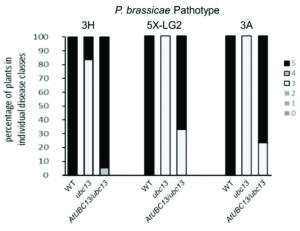Gene editing turns off S genes to improve CR
KEY RESULT:
Researchers use a precise CRISPR/Cas9 based genome editing tool to confer clubroot resistance (CR) by introducing site-specific mutations to disrupt, or inactivate, susceptibility (S) genes.
PROJECT TITLE, PRINCIPAL INVESTIGATOR:
“Establishing transgene-free CRISPR/Cas9 based genome editing platform to improve canola resistance against clubroot disease,”
Wei Xiao, University of Saskatchewan
FUNDING:
SaskCanola, Saskatchewan’s Agriculture Development Fund
PUBLICATION:
Read the full report in the Research section at saskcanola.com.
Clubroot disease significantly affects canola seed quality by reducing oil content and seed weight. The most effective solution to control this disease today is growing clubroot-resistant (CR) cultivars in appropriate rotations. However, single, race-specific, dominant resistance (R) genes cannot provide durable resistance and are easily broken down with a shift in the pathogen population.
In a three-year project, researchers investigated a new alternative strategy based on susceptibility (S) genes that have the potential to be durable in the field. Different from conventional breeding, disease resistance can be easily conferred by introducing site-specific mutations to disrupt, or inactivate, S genes using a precise CRISPR/Cas9 based genome editing tool. Inactivation of S genes can result in enhanced resistance to clubroot. CRISPR is more accurate, faster, simpler and cheaper than earlier gene editing methods. It can be used to add, delete or replace DNA sequences, and it can be used to turn a gene on or off.
The objectives for this project were to establish a CRISPR/Cas9-based genome-editing platform to support canola breeding programs against clubroot disease, to identify novel clubroot resistance genes and to create novel resistance allelic variants in elite canola germplasm.

Results
Researchers first developed an S gene strategy to improve canola clubroot resistance. They identified novel S candidate genes from the model plant Arabidopsis thaliana and investigated the genes’ roles and function in clubroot susceptibility.
Researchers then designed CRISPR/Cas9 constructs targeting these S genes and then transformed canola plants using an agrobacterium-mediated canola transformation platform. Selected gene-edited mutant plants were assessed with clubroot disease assays to confirm their conferred clubroot resistance. The results showed that several lines significantly reduced disease severity compared to control plants. SWEET11 and 12, two well-known gene groups belonging to the sucrose transporter gene family, were also targeted for gene editing, with several lines displaying reduced disease severity to clubroot infection.
As a result of the project, researchers successfully developed and demonstrated an S gene based strategy to improve durable clubroot resistance, and established an in-house CRISPR/Cas9 based genome editing platform to accelerate gene discovery, functional characterization and agronomy trait improvement in B. napus. The project identified and functionally characterized two novel S genes in arabidopsis, and edited an additional 22 B. napus S genes through the CRISPR/Cas9 platform that will be available to improve clubroot resistance by either providing molecular markers or resistant germplasm.
Overall, this research has provided an optimized CRISPR/Cas9 tool for faster, more accurate canola breeding, to enhance clubroot resistance in canola, and to open the door to improvements in many other traits important to canola growers. Eventually, the knowledge, germplasm, molecular markers and CRISPR/Cas9 genome editing tools generated from this project will accelerate breeding cycles, which will reduce the investment costs of breeding new cultivars and benefit the Canadian canola industry.





